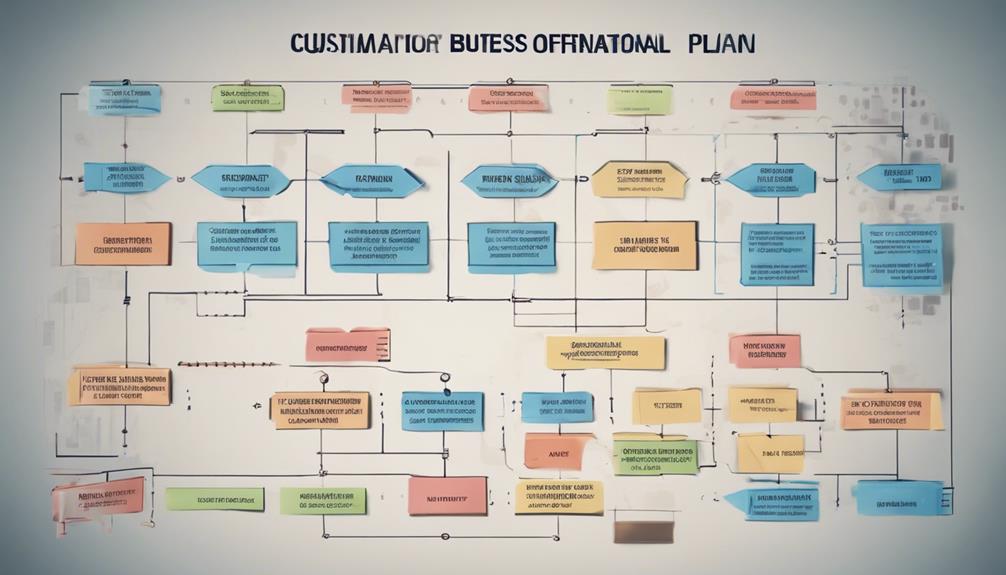So, you think your business plan is a one-size-fits-all masterpiece that will conquer the US market? Well, think again.
Customizing your business plan for the US market goes beyond a mere formality; it's a strategic necessity that can make or break your success.
In a landscape where adaptability is key and local nuances matter more than you might imagine, tailoring your approach could be the game-changer you've been searching for.
Key Takeaways
- Aligning with US market intricacies enhances strategic edge.
- Adapting to legal requirements showcases commitment and adaptability.
- Cultural considerations aid in tailoring business strategies for success.
- Identifying target audience and competition is crucial for effective targeting.
Benefits of Tailoring Your Business Plan
Tailoring your business plan for the US market enhances your strategic edge by directly aligning with market intricacies and consumer demands. For a new business venturing into the US market, customization is key to gaining a competitive advantage. By tailoring your plan to meet the specific requirements of the US market, you demonstrate a proactive approach to understanding the nuances of doing business in the country. This level of customization not only showcases your commitment to meeting the unique needs and expectations of American consumers but also positions your business as one that's adaptable and responsive to changing market dynamics.
Moreover, customizing your business plan can also open doors to potential investors in the US. Showing a clear alignment with local market conditions and opportunities can significantly increase your chances of attracting investment from sources like the Small Business Administration. By tailoring your plan, you signal to investors that you have a comprehensive understanding of the US market landscape and are well-prepared to navigate its challenges and capitalize on its opportunities.
Understanding US Market Dynamics

To succeed in the US market, you must analyze market trends, gain insights into consumer behavior, and understand the competitive landscape. By recognizing these key points, you can tailor your business strategies effectively to meet the demands of the American market.
Market dynamics in the US require a strategic approach that aligns your business plan with the ever-evolving preferences and trends of American consumers.
Market Trends Analysis
Analyzing US market trends provides crucial insights into consumer preferences, economic indicators, and industry dynamics, essential for strategic business planning and decision-making. Understanding market trends involves:
- Identifying industry growth sectors and competitive landscapes.
- Predicting market shifts and staying ahead of competitors.
- Assessing market demand and pricing strategies for business planning.
- Tracking technological advancements, regulatory changes, and cultural influences.
- Evaluating potential risks and opportunities to adapt strategies accordingly.
This thorough analysis enables you to tailor your business plan to the specific nuances of the US market, ensuring your strategies align with current market dynamics and increasing your chances of success.
Consumer Behavior Insights
Understanding the dynamics of the US market involves delving into consumer behavior insights shaped by cultural diversity, technological advancements, and evolving preferences. When crafting your business plan for the US market, it's crucial to consider how these factors influence consumer decisions.
In this market, consumers are increasingly driven by convenience, personalization, and ethical considerations. Millennials and Gen Z, in particular, are pivotal in steering trends towards e-commerce and brand loyalty. Moreover, online shopping habits, social media impact, and sustainability concerns heavily influence purchasing choices.
To succeed, aligning your business strategies with these values is imperative. By prioritizing localization, enhancing customer experience, and offering competitive pricing, you can position your business effectively within the competitive landscape of the US market.
Competitive Landscape Overview
In grasping the competitive landscape of the US market, delve into an analysis of consumer behavior, trends, and industry regulations. Understanding these aspects is crucial when customizing your business plan for starting a business in the US. Consider the following key points:
- The US market is highly competitive, with over 30 million small businesses vying for market share.
- Competitor analysis is crucial for identifying strengths, weaknesses, opportunities, and threats in the market.
- The market is diverse, with varying preferences, demographics, and purchasing power across different regions.
- Adapting your business plan requires a deep understanding of local competition and consumer preferences.
- Stay informed about market trends to stay ahead in the competitive landscape and increase your chances of success.
Identifying Target Audience and Competition

How can you effectively pinpoint the target audience and competition in the US market for your business plan's success? To tailor your business plan for the US market, it is crucial to identify your target audience and analyze the competition comprehensively. By understanding demographic trends, consumer behavior, and purchasing power, you can effectively reach your potential customers. Similarly, assessing market share, pricing strategies, product offerings, and brand positioning of your competitors is essential for developing a competitive edge.
Consider the following table to guide you in identifying your target audience and competition:
| Target Audience | Competition |
|---|---|
| Demographic trends | Market share |
| Consumer behavior | Pricing strategies |
| Purchasing power | Product offerings |
| Customer needs | Brand positioning |
Adapting to Legal and Regulatory Requirements

To ensure your business plan's alignment with the US market, it's imperative to meticulously incorporate and adhere to the legal and regulatory requirements specific to the country. Adapting to these requirements involves several key considerations:
- Understanding US legal and regulatory requirements is crucial for compliance with specific laws such as labor laws, tax regulations, and industry-specific regulations.
- Incorporate details on intellectual property protection, data privacy laws, and consumer protection regulations in your business plan for US market success.
- Address FDA regulations for industries like food, pharmaceuticals, and medical devices to ensure product compliance.
- Consider state-specific regulations, including licensing requirements, zoning laws, and environmental regulations when customizing your business plan.
- Adhere to federal regulations like the Securities and Exchange Commission (SEC) rules for financial reporting and disclosure for successful business plan customization in the US market.
Incorporating Cultural Considerations

To ensure your business plan resonates in the US market, understanding how cultural norms impact consumer behavior is key.
Tailoring your communication styles to align with American preferences can enhance market receptivity.
It's imperative to recognize and adapt to local preferences to effectively connect with US consumers and drive business success.
Cultural Norms Impact
Incorporating cultural considerations into your business plan for the US market is essential to align with the values of individualism, diversity, and innovation highly prized in American society.
- Recognize the importance of cultural nuances in your business strategy.
- Show respect for the diverse US population through your customized approach.
- Enhance customer engagement and loyalty by adapting to US cultural norms.
- Build rapport with American consumers and establish trust with key stakeholders.
- Set your company apart from competitors and drive long-term success by acknowledging and incorporating cultural differences.
Communication Styles Differ
Aligning your communication style with American preferences is pivotal for establishing strong connections and credibility in the US market. When customizing your business plan, consider the direct and assertive communication style prevalent in the US. Adapting your language to be clear, concise, and results-oriented can help convey confidence and credibility to potential partners and investors. To illustrate this further, the table below outlines key differences between communication styles in the US and other cultures:
| Communication Styles | US Market |
|---|---|
| Directness | Emphasis on clarity and brevity |
| Assertiveness | Confidence in expressing opinions |
| Professionalism | Formal tone in business interactions |
| Results-Oriented | Focus on measurable outcomes |
| Engagement | Active participation and discussion |
Understand Local Preferences
Understanding local preferences is essential for effectively incorporating cultural considerations into your business plan for the US market. When customizing your strategies, consider the following:
- Tailoring Products: Adapting your offerings to meet specific American consumer needs and tastes.
- Cultural Nuances: Recognizing language, values, and buying behaviors that influence market perception.
- Marketing Alignment: Adjusting strategies to resonate with American cultural norms for better engagement.
- Brand Perception: Enhancing how your business is perceived by aligning with cultural expectations.
- Market Share: Increasing customer satisfaction and market share through culturally informed business planning.
Implementing Marketing Strategies for US Market

To effectively penetrate the US market and maximize your business's potential, implementing targeted and culturally resonant marketing strategies is paramount. Understanding the US market demographics and consumer behavior is key to tailoring your approach. By researching competitors and industry trends, you can carve out a unique value proposition for your business.
Adapting your marketing messages to align with cultural nuances and preferences of US consumers can significantly impact your success. Leveraging digital marketing tools like social media and search engine optimization, popular in the US, can enhance your reach and engagement. Additionally, building relationships with local influencers and strategic partners can help establish credibility and visibility in the competitive US market.
Financial Projections and Funding Sources

When crafting financial projections for your US market business plan, aim for accuracy in revenue forecasts to build investor confidence. Consider exploring diversified funding options beyond traditional bank loans to increase financial stability and growth potential.
Demonstrating a clear understanding of revenue streams and accessing various funding sources will enhance your business plan's appeal to potential investors.
Revenue Forecast Accuracy
Enhance your business plan's credibility and secure funding by tailoring financial projections to the specific demands of the US market. When customizing your financial projections for the US market, consider the following:
- Market Trends: Incorporate current US market trends into your revenue forecasts to showcase adaptability.
- Consumer Behaviors: Analyze consumer behaviors unique to the US market to project accurate sales figures.
- Economic Conditions: Factor in the prevailing economic conditions in the US for a realistic revenue forecast.
- Investor Confidence: Detailed financial projections instill confidence in investors, increasing funding prospects.
- Adapt Funding Strategies: Customize funding strategies to align with US investor preferences, improving fundraising success rates.
Diversified Funding Options
Considering the tailored financial projections for the US market, exploring diversified funding options becomes crucial for optimizing capital acquisition and fueling business expansion. In your business plan, highlighting specific funding sources such as venture capital, angel investors, and bank loans tailored to the US market can enhance your financial planning. Understanding niche funding avenues like Small Business Administration (SBA) loans or leveraging crowdfunding platforms can optimize your funding strategy.
Customized financial projections not only demonstrate your grasp of the US market but also boost credibility with potential investors. Adapting funding strategies to the US market landscape maximizes your chances of securing capital and driving business growth. Detailed financial forecasts aligned with US market trends are essential for attracting investors and securing funding for expanding your business.
Creating a Strong Value Proposition

Crafting a strong value proposition tailored to the US market requires a deep understanding of American consumers' specific needs and preferences. In the US market, your value proposition should clearly communicate the unique benefits and value your business offers to target customers. Here are some key strategies to create a compelling value proposition:
- Understand American consumers: Dive deep into the needs, preferences, and behaviors of US customers to tailor your value proposition effectively.
- Increase brand perception: Customizing your value proposition for the US market can enhance brand perception, customer loyalty, and competitiveness.
- Differentiate from competitors: An effective value proposition can set your business apart, attracting more customers and driving higher sales.
- Drive revenue growth: Crafting a value proposition that resonates with US consumers is crucial for sustained growth and success in the American market.
- Address desires and expectations: Ensure your value proposition addresses the specific desires and expectations of US customers to maximize its impact on your business goals.
Building a Solid Operational Plan

To build a solid operational plan tailored for success in the US market, meticulous attention to local regulations, consumer preferences, and the competitive landscape is imperative. Conducting detailed market research will help you identify essential operational requirements like distribution channels, logistics, and customer service standards specific to the US market.
Adapting your operational plan to align with US market trends and customer expectations can significantly boost your business's success and longevity. Establishing strong partnerships with local suppliers, manufacturers, and service providers is crucial for ensuring smooth operations in the US market.
Additionally, integrating technology solutions and automation into your operational plan can streamline processes and enhance overall efficiency in this competitive market environment. By prioritizing these aspects in your operational strategy, you can position your business for sustainable growth and success in the dynamic US market landscape.
Leveraging Technology and Innovation

Leveraging technology and innovation is essential for businesses aiming to thrive in the competitive landscape of the US market. By integrating cutting-edge solutions and fostering a culture of innovation, your business can strategically position itself for success.
Consider the following strategies to harness the power of technology and innovation in your business plan:
- Enhanced Efficiency: Implement technology-driven processes to streamline operations and boost productivity.
- Customer-Centric Innovation: Develop innovative products or services that cater to the preferences of tech-savvy American consumers.
- Adaptation to Market Trends: Stay informed about the latest US market trends and leverage technology to adapt swiftly.
- Competitive Edge: Utilize technology to differentiate your offerings and stay ahead of competitors in the dynamic US market.
- Meeting Consumer Demands: Embrace innovation to meet the evolving demands and expectations of US consumers effectively.
Seeking Professional Assistance and Guidance

Professional guidance and expertise play a pivotal role in refining your business plan for the US market, ensuring alignment with regulatory frameworks and market dynamics.
Seeking professional assistance can provide valuable insights into navigating the complex regulations and compliance requirements specific to the US market. Experts can help tailor your business plan to align with cultural norms, consumer preferences, and current market trends, increasing its relevance and effectiveness.
By working with professionals, you gain access to industry-specific best practices and strategies that can enhance your chances of success in the US market. Moreover, customizing your business plan with professional help can boost credibility and trust among potential investors and partners, showcasing a commitment to thorough planning and strategic execution.
Leveraging expert advice can optimize your market entry strategy, setting a solid foundation for sustainable growth and profitability in the competitive US market landscape.
Frequently Asked Questions
Why Is It Important to Create a Successful Business Plan?
Creating a successful business plan is crucial for your venture. Market research guides informed decisions, while strategic planning outlines clear goals. This process helps you anticipate challenges, seize opportunities, and stay ahead of trends.
What Are the Three 3 Important Purposes of a Business Plan?
When creating a business plan, it's crucial to understand its three key purposes.
Firstly, strategic planning helps set clear objectives and outlines the steps needed to achieve them.
Secondly, market analysis provides insights into consumer behavior and competition, guiding your growth strategy.
Lastly, financial projections offer a roadmap for sustainable profitability.
What Is One Purpose of Writing a Business Plan for Entering the Market?
When entering a new market, writing a business plan serves as your blueprint for success. It helps you strategize your market entry by outlining key steps for strategic planning.
Why Is It Important to Transform a Business Plan Into an Action Plan?
When transforming plans into action, you propel your business forward. Taking action is crucial because it moves you from the realm of ideas to tangible progress.
By creating an action plan, you establish clear steps, deadlines, and accountability. This transformation ensures that your goals aren't just aspirations but achievable objectives.
It empowers you to track progress and make necessary adjustments, driving your business towards success.
Conclusion
By customizing your business plan for the US market, you're positioning yourself for success in a competitive landscape.
While it may seem daunting, adapting to local needs and preferences is essential for sustainable growth and profitability.
Anticipating objections and addressing them head-on will set you apart from the competition and showcase your strategic mindset.
Embrace the challenge of customization to unlock the full potential of your business in the dynamic US market.